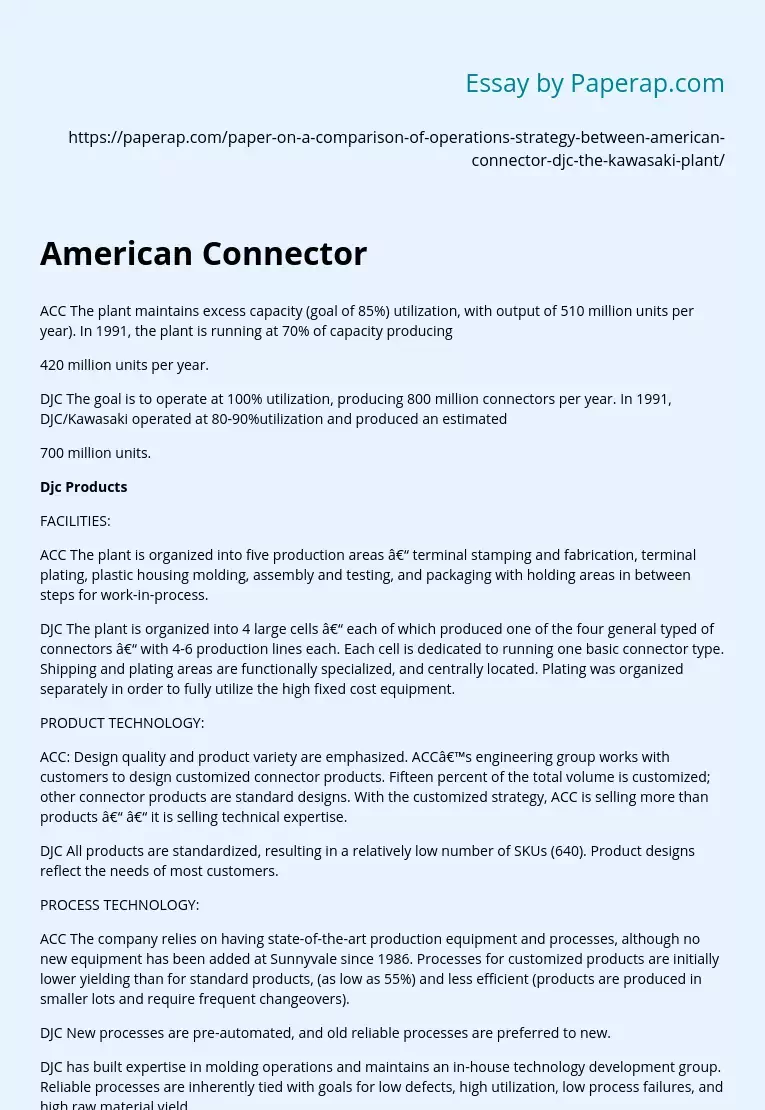American Connector
ACC The plant maintains excess capacity (goal of 85%) utilization, with output of 510 million units per year). In 1991, the plant is running at 70% of capacity producing
420 million units per year.
DJC The goal is to operate at 100% utilization, producing 800 million connectors per year. In 1991, DJC/Kawasaki operated at 80-90%utilization and produced an estimated
700 million units.
Djc Products
FACILITIES:
ACC The plant is organized into five production areas – terminal stamping and fabrication, terminal plating, plastic housing molding, assembly and testing, and packaging with holding areas in between steps for work-in-process.
DJC The plant is organized into 4 large cells – each of which produced one of the four general typed of connectors – with 4-6 production lines each. Each cell is dedicated to running one basic connector type. Shipping and plating areas are functionally specialized, and centrally located. Plating was organized separately in order to fully utilize the high fixed cost equipment.
PRODUCT TECHNOLOGY:
ACC: Design quality and product variety are emphasized. ACC’s engineering group works with customers to design customized connector products.
Fifteen percent of the total volume is customized; other connector products are standard designs. With the customized strategy, ACC is selling more than products – – it is selling technical expertise.
DJC All products are standardized, resulting in a relatively low number of SKUs (640). Product designs reflect the needs of most customers.
PROCESS TECHNOLOGY:
ACC The company relies on having state-of-the-art production equipment and processes, although no new equipment has been added at Sunnyvale since 1986. Processes for customized products are initially lower yielding than for standard products, (as low as 55%) and less efficient (products are produced in smaller lots and require frequent changeovers).
DJC New processes are pre-automated, and old reliable processes are preferred to new.
DJC has built expertise in molding operations and maintains an in-house technology development group. Reliable processes are inherently tied with goals for low defects, high utilization, low process failures, and high raw material yield.
WORK FORCE:
ACC Sunnyvale employs 396 employees. 54% are direct labor, 56% are indirect labor.
DJC Kawasaki employs 94 employees, 68% are direct labor and 32% are indirect labor. Management’s goal is to decrease the number of employees over time.
PRODUCTION PLANNING:
ACC The plant operates 120 hours/week on a 3 shift per day, 5 day per week schedule
(called 3×5), 50 weeks of the year (approx. 7,920 hours/year). Relatively long lead times (10 days for standard products and 2-3 weeks for special orders), short
production runs (averaging 1.5 to 2 days), and small finished good inventory (38 days) are all manifestations of the plants strategy. These operating characteristics are typical for a plant with a high number of SKUs (4,500) and a flexible production schedule that accommodates customer requests.
DJC DJC operates 168 hours/week on a 24 hour per day, 7 day per week schedule (called 3×7), operating 330 days per year (approx 7,920 hours/year). Changes to the production schedule, such as for special orders, are not permitted. Relatively short lead-times (compared with ACC/Sunnyvale), long production runs, and large finished good inventory are all characteristics of Kawasaki’s strategy.
QUALITY:
ACC The strategy calls for delivering what the customers want, when they want it. Rather than defining quality as conformance to internal production schedules and product specifications, the company defines its quality as conformance to customer needs: “we deliver near perfect connectors, and we never miss a scheduled delivery.”
DJC Quality is defined as conformance (low defect rates). Explicit goals for quality were established including a targeted raw material yield of 99% and fewer than one defect per million.
ORGANIZATION:
ACC American Connector is a marketing and engineering driven company, with manufacturing playing only a secondary role.
DJC Manufacturing plays a key role in determining the strategy of the company.
SUMMARY:
ACC American Connector has configured its operations to emphasize flexibility and esponsiveness to customers. This operations strategy leads to higher costs. For example, there are costs associated with flexibility, such as keeping extra capacity (maximum utilization is 85%, rather than 100%). Similarly, there are additional costs associated with offering a wider variety products (increased in total changeover times) and using expensive materials in products (such as gold, rather that tin). Adjusting the productions schedule to suit special orders also adds costs, as do short production runs and lower yielding processes (which result because of small, customized product lots).
DJC Like American Connector, DJC has an operations strategy which is closely aligned with its competitive priorities. However, in the case of DJC, the chief competitive priority is low cost. High utilization, strict production scheduling and inventory control, low product variety, and use of less expensive materials in products (such as tin, instead of gold) all contribute to lower costs. Product innovation and responsiveness to customer needs are less valued. With its strategy, DJC is lower cost than American Connector, but less innovative and less flexible.
American Connector. (2019, Dec 05). Retrieved from https://paperap.com/paper-on-a-comparison-of-operations-strategy-between-american-connector-djc-the-kawasaki-plant/

